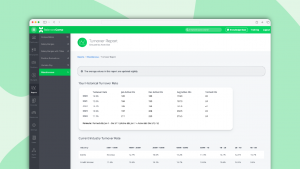By Philippe Asselin

How does that even make sense—can turnover be “too” low? And compared to what?
When it comes to employee turnover, financial institutions often focus on reducing it, equating lower turnover with decreasing costs, stability, and success. Lower turnover means fewer replacement costs and less time spent recruiting and onboarding new employees, which, on the surface, is a win. For all practical purposes, it is a win. However, what if too low of low turnover is quietly working against your organization’s long-term goals?
“Turnover isn’t just a number; it’s a signal of your organization’s overall health.”
While stability may feel good, it’s worth questioning whether low turnover truly serves your institution—or possibly masking underlying issues. If growth, profitability, operational efficiencies, customer service, compliance, or other key metrics are stagnating- or even worse- declining- is there a connection? A culture too comfortable with the status quo might be the culprit. Even with low turnover, motivators, perspectives, or strategic initiatives may have stalled, creating an environment where inflows and outflows of talent have slowed to a crawl.
The question then becomes: Is your turnover low because of your amazing culture where employees are engaged and thriving, or because the organization has stopped evolving? What do the numbers say?
Generational Perspectives: How Loyalty and Learning Differ
Low turnover often feels positive because, as mentioned, it can mean reduced replacement costs and a seemingly steady workforce. “They really like it here, and we finally got it right,” can be what many leaders believe. However, in today’s evolving workplace, especially with younger generations making up a significant portion of the labor market, loyalty, and tenure are viewed differently.
For more seasoned generations, staying with one employer for many years may be a badge of honor and a sign of commitment, with the hope of a good return on their investment of time and effort. It may have worked great that way before global competition and automation, but as for now, somewhere along the way, something went awry, where tenure was punished in some places and rewarded in others. As a result, tenure is not valued the same by all.
Younger generations tend to prioritize development, learning, and growth over long-term tenure, as they should. Promotions are valued even if externally to another organization, especially when coupled with a nice increase in compensation, as many have seen over the past decade. They may interpret a lack of change as a lack of opportunity. An overly stable workforce may indicate that the organization isn’t investing enough in career development, strategic change, or learning initiatives—elements essential to attracting and retaining the best talent across generations.
The pandemic has ushered in record numbers of people retiring—up 30% over prior years. This change continues to deplete bench strength in key leadership and the most complex roles in organizations. The blessing of low turnover suddenly becomes the curse, as some companies face insurmountable gaps between highly tenured leadership/complex roles and what is available in their talent pools internally and externally.
Mergers and acquisitions become a plan for some as they cannot afford the replacement costs for the succession plans or at least are willing to do what is required to make another plan viable. Lack of investment and development in employees and the ability to develop new leaders can cause organizations to become unsustainable. Focus on efficiency becomes paramount to the success of many organizations as they leverage lower operating costs to invest in their future talent pool.
A Healthy Organization Mirrors a Healthy Ecosystem
Some leaders think of a thriving organization as a dynamic ecosystem, much like a flowing aquifer where nutrients and wildlife circulate freely, creating balance and vitality. Movement is essential: new strategies flow in, human capital creates new synergies, and outdated processes, ideas, and approaches become phased out.
When inflows and outflows stall, the organization becomes stagnant, much like the Dead Sea—where nothing thrives except the most basic forms of life. Low turnover doesn’t mean people need to be fired or replaced, but it does signal the need to examine whether motivators, perspectives, or strategies have become static. Employees may stay because they are comfortable or afraid of change, not because they are growing or contributing to the organization’s evolution.
Targeted initiatives in recruiting practices, career pathing in and out of the organization, leadership assessments, change management, strategic development, and employee engagement can help refresh your culture and reinvigorate talent inflows and outflows without resorting to drastic measures like layoffs, which ultimately can do more harm than good.
Smaller vs. Larger Financial Institutions: Tailored Challenges
For smaller financial institutions, low turnover can provide a sense of stability and momentum, but the organizational size also presents unique opportunities for agility. With fewer employees, it’s easier to implement initiatives like job enrichment, cross-functional collaboration, and quick decision-making. But the question becomes: Who will own those initiatives, and has time to do it right?
Employees in smaller organizations often wear multiple hats, which appeals to those eager to accelerate their development, diversify their skill sets, and contribute across various functions. Forward-thinking organizations can capitalize on this by aligning compensation with evolving responsibilities and fostering open conversations about career progression. While this approach can retain adaptable, high-performing employees longer, smaller institutions must also plan for inevitable turnover when career advancement opportunities elsewhere become the next logical step for these individuals.
While resource-rich and capable of scaling initiatives, larger institutions face challenges in maintaining flexibility and adaptability. The number of available opportunities and diversity of options to choose from are very desirable with larger organizations. With their significant investments in systems and processes, they often prioritize structure and specialization, which can create efficiencies but may also lead to rigidity. Talent aligned with one initiative may not meet the demands of the next, particularly in fast-changing digital environments. Additionally, large organizations may struggle with employee engagement as individuals feel less connected to leadership or strategic priorities. Change management often becomes a specialized function, diluting creativity and slow problem-solving as decisions require broader team collaboration.
The Paradox of “Good Enough”
Organizations often focus on solving big problems or addressing glaring deficiencies, but there’s a paradox worth considering: average or “adequate” numbers can be more dangerous than bad ones. Poor performance forces action—it demands immediate movement, focus, and strategy to correct the issue. But when things seem “fine,” organizations can slip into a cruise control mentality, operating in the comfort of the status quo. This stagnation can be deceptive, as it allows competitors to innovate, adapt, and ultimately surpass those stuck in a cycle of complacency.
Low turnover, when paired with flat performance metrics, is a prime example of this paradox. It may feel stable, but without proactive efforts to engage and evolve, it risks creating an environment where employees are simply maintaining rather than driving growth and innovation.
In both small and large institutions, low turnover should not be viewed as inherently good or bad on its own, but should be coupled with other metrics to determine the organization’s path. Low turnover and lower organizational performance can signal the need to reevaluate employee engagement, career development, and innovation strategies. Striking the right balance can ensure your organization remains dynamic, competitive, and primed for long-term success.
BalancedComp: Your Partner in Workforce Optimization
At BalancedComp, we understand the nuances of turnover and how to determine the perfect balance. Low turnover can be a desirable goal and an asset—but only when paired with strategic initiatives that ensure employees are engaged, growing, and contributing to organizational success.
We help financial institutions:
- Benchmark pay structures against market data.
- Align variable compensation with industry trends.
- Compare benefits to industry trends.
- Assess headcount by asset size in relation to organizational goals.
- Audit and refine your compensation philosophy.
With our industry-leading systems and consulting, we help organizations with many compensation-related challenges. In addition to structuring grades and ranges for an effective compensation system, BalancedComp includes a first-to-market Turnover Report based on asset classification and industry.

How does your bank or credit union compare in your industry, and in your asset size?
Contact us today to find out how BalancedComp can help you maintain a dynamic, thriving workforce that drives growth and innovation.
Back to Blog

